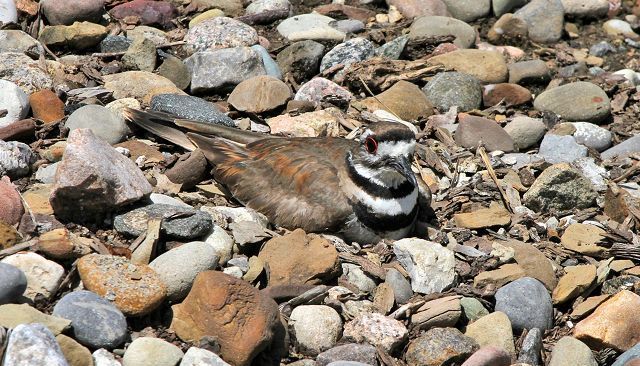Nesting Killdeer a common sight in our area this time of year
- Michelle Wood: SWCD
- June 9, 2014
- 2123
By far the most common and easily-encountered member of the plover family is the familiar Killdeer. Not only are they found in a wide variety of habitats, their choices of places to nest often put them in close contact with us. Instead of hiding their nests deep in thick vegetation, Killdeer choose open areas, often with gravel, which may even be on our driveways.
If thats the case, Donald and Lillian Stokes describe well what happens if you get too close to the well-camouflaged location of their eggs: they are sure to lead you away from the site by calling piteously and dragging their wings and tail along the ground. (A Guide to Bird Behavior, Volume 2). Amazingly, many such nesting efforts succeed. One reason is that the young Killdeer are able to run and feed soon after they emerge from the eggs. In the above-mentioned book, the Stokes have also included detailed information on the different displays and calls in the Killdeer repertoire.
Keeping an eye on a Killdeer nest from day to day may give you a chance to see the young birds soon after they hatch. The tiny Killdeer are fun to watch as they run around the area with the parent birds, looking for food and trying to stay out of the way of cars, cats and people who may share their home.
Killdeer are common nesters throughout our country, although birds in the northern areas migrate as far as South America for the winter. Killdeer migrate at night. Populations have been increasing during the last century, especially in the eastern half of the country, as indicated by breeding bird surveys in Ohio and beyond.
Bruce Peterjohn, author of Birds of Ohio has lots of helpful information in his 2001 second edition. Here in Ohio, a few Killdeer stick out the winters but most leave, with the early birds returning with the first warming trend in February. By March they are well established around the area, with males arriving first and setting up territories. Nesting usually begins in April and continues into June and even early July, with some birds attempting second broods.
Southward migration begins early, with flocks gathering by late June and some leaving by early July. The fall migration is spread out, with some Killdeer hanging around until November or even December. Warmer winters most likely result in more Killdeer staying around longer or even throughout the winter.
During the fall migration small flocks of Killdeer may be found, both along Lake Erie and around the state, although the forested southeastern part of Ohio has lower numbers. At times, larger flocks show up, rarely with more than 1,000 being possible (Peterjohn, Birds of Ohio). Locally, we have often seen flocks of Killdeer at places like Killbuck Marsh and Funk Bottoms Wildlife Areas, Pleasant Hill Lake and Berlin Reservoir.
Although the Killdeer is our most common member of the plover family, we also see other plovers during spring and fall migration. Small plovers such as the Semipalmated Plover can sometimes be confused with young Killdeer. Other plovers that migrate through our area include Black-bellied and American Golden Plovers. It is possible for a Piping or Snowy Plover to show up in Ohio but they are extremely rare and more likely to be found somewhere along the Lake Erie shoreline.
So, keep your eyes open for Killdeer these days and enjoy the shows that they may put on for you. Good birding!
Bruce Glick is available by email at birderbruce@yahoo.com and phone at 330-317-7798.




